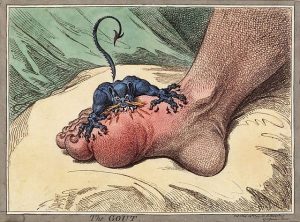… have appeared – shockingly pink, slender and tender, uncovered and unabashed –but lethal.
Some unfortunates have mistaken them for edible ramsons, wild garlic. Cardiovascular and respiratory failure follow, around the third day post-ingestion. Initially the symptoms are much like cholera.
All parts of the autumn crocus are highly poisonous. The leaves appear in spring which can confuse. Colchicum autmunale is so named because the origin of the toxic wild plant was ancient Colchis. According to Herodotus this was the Black Sea resort of the soldiers of the fearsome Pharoah Sesostris and is now a region of Georgia.
Another infernal despot, the self-anointed Emperor Napoleon, cut off the supply of claret to England.
The “Continental Blockade” was Napoleon’s attempt to prevent European countries under his control from trading with Britain. Of course, the Royal Navy had its own much more effective blockade of all major French ports.
So smuggling became big business – “Brandy for the Parson, ‘Baccy for the Clerk. Laces for a lady; letters for a spy, watch the wall my darling while the Gentlemen go by!”
Massive casks of wine were too bulky and low-profit to be a commercial proposition for fleet-footed smugglers. Claret was soon supplanted by legally imported port, Portugal being the only British toe hold remaining in mainland Europe.
Port contains high levels of purine, a naturally occurring chemical, which, in those genetically predisposed, gives rise to excess formation of uric acid in the blood. Crystals of urates then deposit in joints, especially in those already damaged. The masses of tiny needle-sharp spicules are highly irritant, causing an agonising inflammatory reaction.
Archetypal gout occurs in big toe joints as British boys have always kicked balls.
William Pitt the Younger, aged 24 when he became Prime Minister in 1783, suffered chronic ill health. His doctors encouraged him to drink a daily bottle of port for its supposed medicinal benefits.
Pitt developed an inordinate liking for it, and fast became victim to multiple attacks of acute gout.
“Gout is the distemper of gentlemen” and closely associated with wealth and good living. Those populating the political world of the time were certainly affluent, and well able to purchase as much port as they wished to drink.
It was not until 1878 that port was fortified, reaching up to 22% alcohol by volume, but in the 18th century port was around the same strength as claret at 10%. Wine bottles then contained around 500ml. Nevertheless, men were measured by their consumption – Pitt and Sheridan became “six bottle men”. Ten bottle men were not uncommon.
Gout became epidemic. The only known remedy was the snake oil eau medicinale d’Husson, “French medicine”. Its formula was a murky secret and it had to be “imported” ─ smuggled – extremely rewarding as it came in extortionately expensive little bottles.
There was a rife rumour that the port deluge and the resultant tsunami of gout were an elaborate French plot to poison British politicians.
Nobody knew then that the active constituent of eau medicinale was an alcoholic extract from the corms of naked ladies ─ colchicum autumnale, the autumn crocus.
“Colchicine” was not purified until 1893. It eventually received approval from the
US Food and Drug Administration for the treatment of acute gout in August 2009, by which time it had been overlooked by mainstream medicine for four thousand years.




